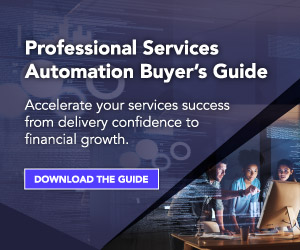
As a professional services leader, you’re probably all too aware of the limits of one-off software implementation methods.
In today’s business landscape, these outdated methods fail to meet clients’ standards for flexibility and optimization. Too often, they create a gap between an organization’s strategy and its actual implementation. This leads to delays, poor performance, and lost value.
Because of this, many organizations are turning to Professional Services (PS) subscription services. This offers several service delivery elements bundled into a single subscription that covers a wide range of functions. The result is continuous customized support to help the customer reach their full potential.
PS subscription services allow clients to reach their goals without unexpected expenses, resource gaps, or poorly informed decisions through direct access to experts from your company. They offer a more predictable, scalable, and cost-effective option for today’s customers.
So, if PS subscription services are the future, how can you successfully implement them to ensure your company’s success?
Read on to learn how customer-centric subscription services can help bridge your strategy and implementation gap and how you can avoid common pitfalls. Use this to lead your organization to success.
Design the Program with Customer Needs in Mind
First things first, there are real pain points when shifting to a PS subscription model.
Many talented professional service leaders struggle to maintain customer-centricity, work with inflexible systems, and communicate the model’s value to their stakeholders. Overcoming these obstacles is essential for successfully implementing a PS subscription model at your company.
Focusing on customer-centricity is an essential first step. The most effective PS subscription services have a deep understanding of customer needs and preferences.
By prioritizing a customer-centric approach, you can ensure that your subscription model services meet your customers’ unique needs.
To ensure your service fulfills your clients’ requirements, you’ll need to develop a plan to gain insight into their pain points.
You can do this using a variety of methods to invite feedback, including:
- Hosting focus groups
- Running email and SMS campaigns
- Launching live chat surveys
- Reviewing sales calls and conducting user interviews
- Soliciting internal ideas, listening to feedback from customer-facing teams, and reading NPS comments
The key is to gather input on what your target audience is looking for from your service offerings.
This is an essential step that will pave the way for successful strategy execution.
Scale and Adapt Systems for Continuous Improvement
Your next priority is learning how to scale and adapt your subscription model to allow you to improve your services continuously.
Your clients’ needs will constantly evolve, and your services within the subscription model will have to adapt with them.
One of the best ways to do this is by using flexible and agile methods in your work. That means embracing the latest project management tools and an iterative working style. This enables you to make ongoing improvements to your offering based on customer feedback and the ever-changing dynamics of today’s business landscape.
It’s also essential to regularly review and update your subscription offerings, to ensure you’re in line with industry trends.
Don’t forget the change this will have on your internal team. Recognize that your current process and systems may not support this shift. You will probably need to adjust your internal systems, CRM, billing, and execution – and how they are tied together in one ecosystem.
Now for the final and most often overlooked step: getting your stakeholders aligned.
Train and Evangelize for Strategic Alignment
Even the most experienced professional service leaders sometimes forget the importance of persuading their teams of the significant value subscription service offerings can drive.
Start by organizing training sessions across your organization so everyone is aligned on the details of the model and the value it offers. Actively communicate the strategic goals underpinning the system and why it matters to specific teams and stakeholders.
By aligning internal stakeholders across your organization on your larger strategy, you’ll set the stage for better day-to-day execution.
Work with your sales teams to ensure they understand how best to position and sell the new offering. By obtaining a buy-in from internal stakeholders, you will empower them to sell the model.
Develop a clear strategy and mission statement to introduce the model to your customers so they become aware of the new offering and are interested in learning more.
Taking Your Next Steps
Aligning services with customer and organizational needs is the future of professional service delivery. By recognizing this and embracing a PS subscription model, you can create a more client-focused offering and drive value for your business.
By designing your program with customer needs in mind, scaling and adapting your model for continuous improvement, and securing alignment with internal and external stakeholders, you can feel confident in your success.
These steps will position you to create a model that will meet customer needs, deliver value, and ensure your relevance in an always-changing market. New recurring revenue streams will also impact your organization’s profitability. An effective PSA solution can help you reduce your operational costs and streamline your service delivery.
Now that we’ve covered the basics, it’s time to create an action plan. Watch our on-demand webinar to learn the steps for creating a successful PS subscription service.




